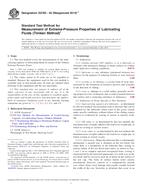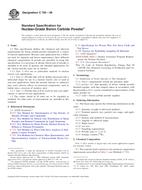Click here to purchase
1.1 These test methods cover procedures for sampling and testing untreated paper to be used as an electrical insulator or as a constituent of a composite material used for electrical insulating purposes.
1.1.1 Untreated papers are thin, fibrous sheets normally laid down from a water suspension of pulped fibers (usually cellulosic), which may contain various amounts of nonfibrous ingredients, and which are calendared, if required, to obtain desired thickness and density. Nevertheless, these test methods are applicable, generally although not invariably, to papers formed by other means, to papers modified (during or after formation) by additions, and to papers given subsequent mechanical treatments such as creping.
1.1.2 As an electrical insulating and dielectric material, paper is considered ?untreated? until it is subjected to a manufacturing process such as drying, impregnation, or varnish treatment.
1.1.3 The test methods given herein were developed specifically for papers having a thickness of 0.75 mm (0.030 in.) or less. A number of these test methods are also suitable for use on other materials such as pulps or boards. Refer to Test Methods D 3376 or Methods D 3394 to determine which tests are applicable to pulps or electrical insulating boards. In the paper industry, some products in thicknesses of less than 0.75 mm are termed ?paperboard?. Such products are included within the scope of these methods.
1.1.4 These test methods are applicable to flexible fibrous-mat materials formed from suspensions of fiber in fluids other than water. These mats may have thicknesses approaching 2 mm, and may contain fibers that are natural, synthetic, organic, or inorganic; fillers that are natural, synthetic, organic, or inorganic; and flexible polymeric binder materials.
1.2 The procedures appear in the following sections:
ProcedureSectionsASTM or TAPPI
Reference
(Modified)
Absorption (Rise of Water)78 to 83
Acidity-Alkalinity-pH45 to 54E 70
Air Resistance98 to 101D 726
Aqueous Extract Conductivity55 to 64
Ash Content40 to 44D 586
Bursting Strength102 to 107D 774
Chlorides (Water-Extractable)165 to 183
Conditioning15D 6054
Conducting Paths138 to 151
Density, Apparent29 to 33
Dielectric Strength152 to 157D 149
Dimensions of Sheet, Rolls andCores16 to 24D 374
Dissipation Factor and Permittivity158 to 164D 150
Edge-Tearing Resistance126 to 130D 827
Fiber Analysis74 to 77D 1030
Folding Endurance108 to 110T 423 and D2176
Grammage25 to 28D 646
Permittivity158 to 164D 150
Heat Stability in Air131 to 137D 827
Impregnation Time84 to 91
Internal-Tearing Resistance121 to 125D 689 or T414
Moisture Content34 to 39D 644 and D3277
Particulate Copper193 to 202
Particulate Iron184 to 192
Reagents4D 1193
Reports14E 29
Sampling6 to 13D 3636
Silver Tarnishing by Paper andPaperboard203 to 206T 444
Solvent-Soluble Matter65 to 73
Surface Friction92 to 97D 528 and T455
Tensile Properties111 to 120D 76, E4
Thickness (see Dimensions)16 to 24D 374
1.3 The tests for Holes and Felt Hair Inclusions and the Stain Test for Fine Pores, have been removed from this compilation of test methods. These test methods were specific to grades of capacitor paper formerly covered by Specification D 1930, which has been withdrawn.
Note 1-This compilation of test methods is closely related to IEC Publication 60554-2. Not all of the individual methods included herein are included in IEC 60554-2, nor are all of the methods in IEC 60554-2 included in this standard. The individual procedures as described in the two standards are in general sufficiently close to each other that it is reasonable to expect that test results obtained by most of the procedures specified in either standard will not differ significantly. However, before assuming that a procedure in these test methods is exactly equivalent to an IEC 60554-2 procedure, the written procedures should be compared closely, and if it seems advisable, test results by the two procedures should be compared.
1.4 The values stated in SI units are to be regarded as standard. The values given in parentheses are mathematical conversions to SI units that are provided for information only and are not considered standard.
1.5 This standard does not purport to address all of the safety concerns, if any, associated with its use. It is the responsibility of the user of this standard to establish appropriate safety and health practices and determine the applicability of regulatory limitations prior to use. See 43.2.1, 71.1, 143.1, 148.1 and 156.1 for specific hazards.
Product Details
- Published:
- 05/01/2008
- Number of Pages:
- 34
- File Size:
- 1 file , 450 KB
- Redline File Size:
- 2 files , 790 KB


